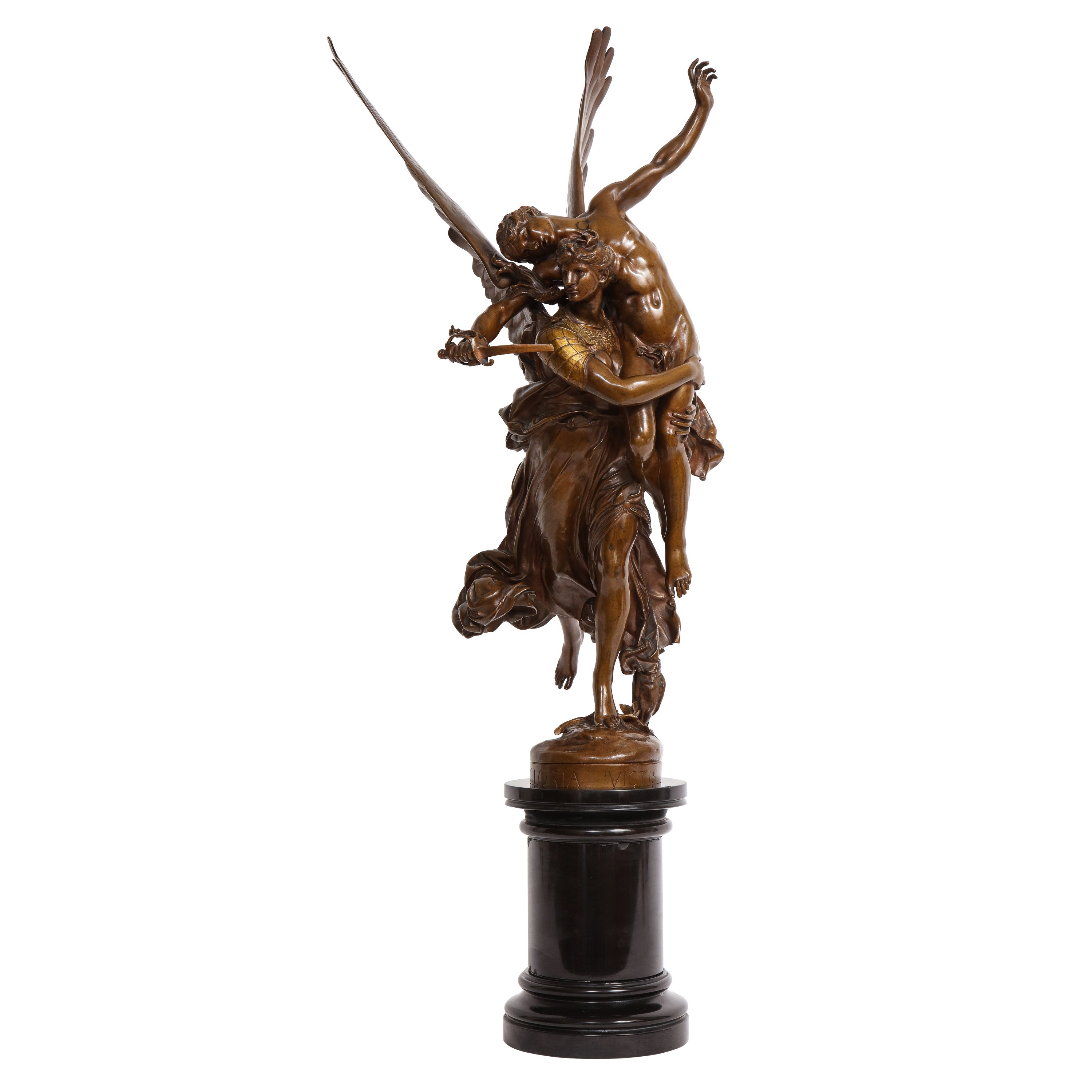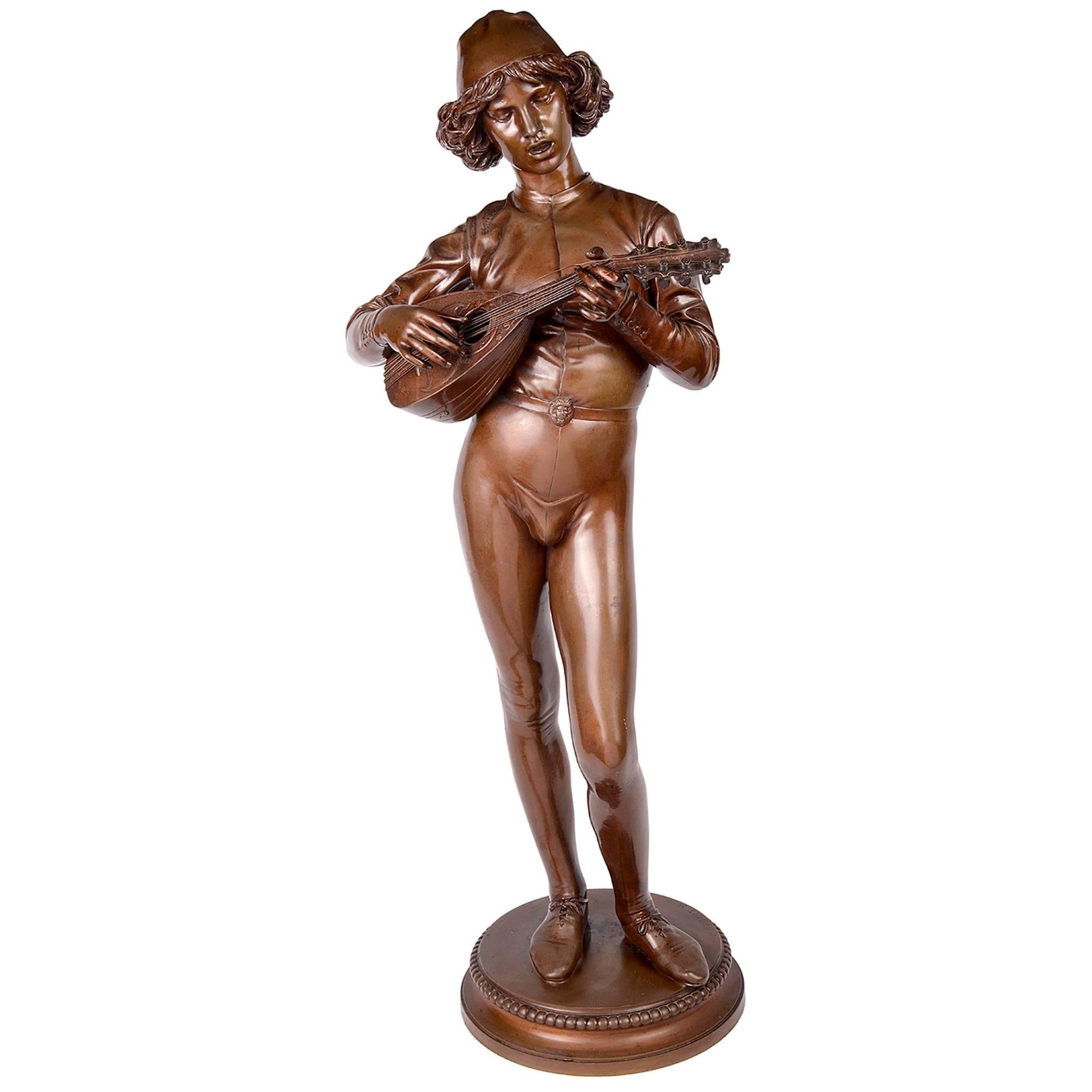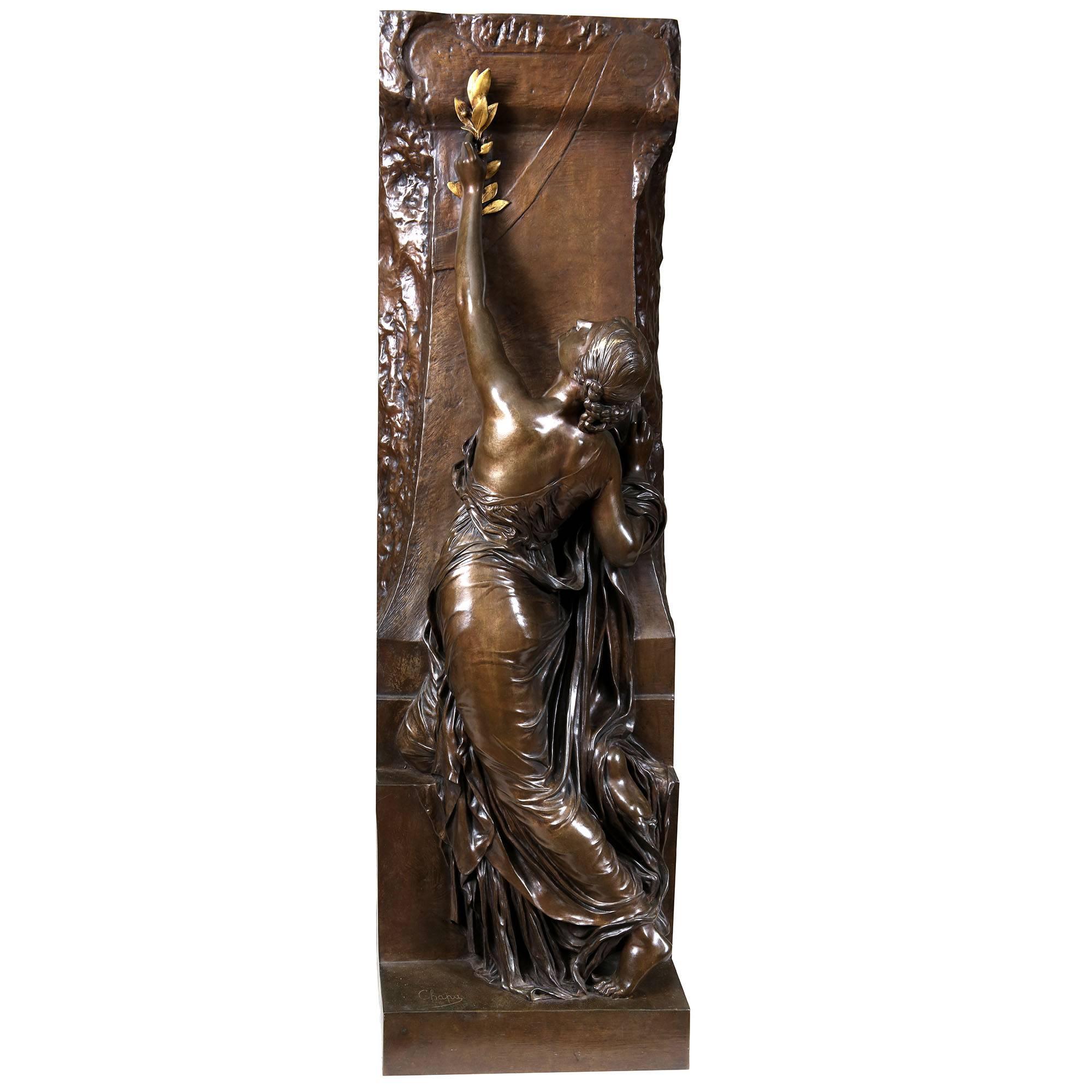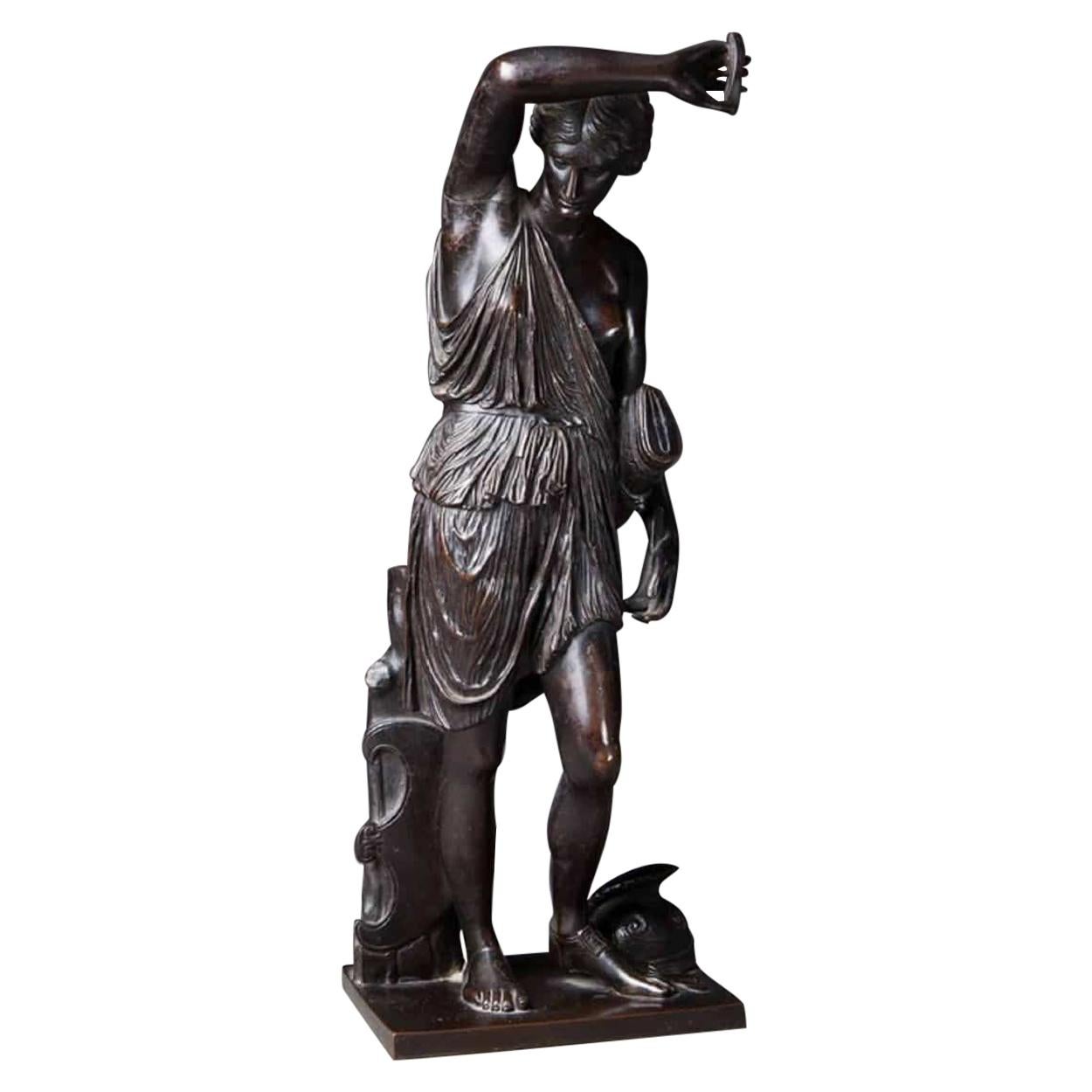Bronze statue of Gloria Victis, circa 1880, by Barbedienne
About the Item
- Creator:F. Barbedienne Foundry (Maker)
- Dimensions:Height: 46.86 in (119 cm)Width: 24.02 in (61 cm)Depth: 19.69 in (50 cm)
- Materials and Techniques:Bronze,Patinated
- Place of Origin:
- Period:
- Date of Manufacture:1880
- Condition:Wear consistent with age and use.
- Seller Location:Brighton, GB
- Reference Number:
F. Barbedienne Foundry
Founded by one-time Parisian wallpaper dealer Ferdinand Barbedienne and engineer Achille Collas, one of the most revered foundries in 19th-century France began with the invention of a revolutionary 1830s-era device that could produce proportional reproductions — large or small — of sculptures. Collas’s machine, which yielded miniature likenesses of antiquities for the interiors of homes the world over, was pivotal to the success of the F. Barbedienne Foundry. The successful firm earned prestigious awards and critical acclaim and created exquisite bronze candleholders, clocks and lamps for a range of wealthy and prominent clients.
The duo first launched their company under the name Société Collas et Barbedienne, and early on, they optimized chemical processes for pigmenting and patinating their bronze statuettes. After Collas died in 1859, Barbedienne forged on alone, and the company’s name changed to simply F. Barbedienne.
Barbedienne employed more than 300 workers at that point, and the Maison created a range of furnishings and decorative objects that featured the integration of marble and ormolu accents. However, with the onset of the Franco-Prussian War of 1870, the foundry was forced to retrofit its molds, and the production of cannons replaced sculptures, furniture and vases.
When Ferdinand Barbedienne passed away in 1891, his nephew and heir, Gustave Leblanc, took over as president, changing the name to Leblanc-Barbedienne. Leblanc expanded production into Germany, the United Kingdom and the United States, carrying on the company's legacy with monumental sculptures, and models and securing production rights for famous statues. Paul-Alexandre Dumas, an Art Nouveau maker and student of Louis Majorelle, succeeded Leblanc until the company's closing in 1952.
Barbedienne pieces had been exhibited regularly in the 19th century and were especially prevalent at Europe’s international expositions and world’s fairs, where they received numerous awards. Today, the Musée d’Orsay in Paris holds dozens of Barbedienne works in its collection, including intricate mirrors, vases and cups created by Louis-Constant Sévin at the foundry. For more than two decades, Sévin created lamps, boxes and more at Maison Barbedienne. Working alongside award-winning chaser Désiré Attarge, Sévin designed Napoleon III-era works that greatly appealed to European nobility.
Other notable artists who collaborated with Barbedienne included Eugene Aizelin, Emmanuel Fremiet, Antonin Mercié, Emile Guillemin, Edouard Lievre, Ferdinand Levillain and Auguste Rodin.
On 1stDibs, find a collection of Barbedienne decorative objects, lighting and collectibles.
- ShippingRetrieving quote...Ships From: Brighton, United Kingdom
- Return PolicyA return for this item may be initiated within 14 days of delivery.
- 19th Century, Barbedienne, Bronze Statue of a MinstrelBy F. Barbedienne FoundryLocated in Brighton, SussexA very good quality 19th Century Bronze statue of a minstrel player, signed Barbedienne.Category
Antique 19th Century Figurative Sculptures
MaterialsBronze
- Shepherds of Arcadia, Barbedienne Bronze, 19th CenturyBy Eugene-Antoine Aizelin, F. Barbedienne FoundryLocated in Brighton, SussexBarbedienne bronze of the Shepherds of Arcadia by Eugene Antoine Aizelin (French 1821-1902) Bergers d'Arcadie. Patinated bronze mounted on a rouge m...Category
Antique 19th Century French Figurative Sculptures
MaterialsBronze
- Classical Bronze Statue of Boy Holding a Mandolin, circa 1880Located in Brighton, SussexA very good 19th century Italian bronze statue of a young boy holding a mandolin. Signed; Alp. de Combay.Category
Antique 19th Century Italian Romantic Figurative Sculptures
MaterialsBronze
- Pair of circa 19th Century Classical Bronzed Arab StatuesLocated in Brighton, SussexA good quality pair of 19th century bronze coated classical male and female Arab figures. Size: 19" (46cm) high.Category
Antique 19th Century French Figurative Sculptures
MaterialsBronze
- Mene, bronze hunting Dogs, circa 1880By Pierre Jules MêneLocated in Brighton, Sussex19th Century bronze group depicting three hunting dogs ferreting. Have a good original patination. Signed; Pierre Jules Mene, French 1810-79 62714 CNKZCategory
Antique 19th Century French Animal Sculptures
MaterialsBronze
- 19th Century Bronze Statue of a Courtier by DuboyBy Paul DuboyLocated in Brighton, SussexA very good quality 19th century bronze statue of French courtier, with a feather hat, cloak and horn. Signed; Duboy Paul Duboy (1830-1887).Category
Antique 19th Century French Figurative Sculptures
MaterialsBronze
- Bronze Figural Sculpture of Gloria Victis by Antonin MerciéBy F. Barbedienne Foundry, Antonin MercieLocated in New York, NYGloria Victis, a winged figure of victory carrying a fallen warrior casted in bronze with brown patina. Inscribed with 'F. Barbedienne. Fonduer' mark and...Category
Antique 19th Century French Figurative Sculptures
MaterialsBronze
- ‘Gloria Victis’, A Patinated Bronze Figural Group by Mercié, Cast by BarbedienneBy Ferdinand BarbedienneLocated in Brighton, West SussexA Patinated Bronze Figural Group of ‘Gloria Victis’ (‘Glory to the Vanquished’), Cast by Ferdinand Barbedienne from the Model by Marius-Jean-Antonin Mercié (French, 1845-1916). ‘Gloria Victis’ (‘Glory to the Vanquished’). Bronze, gilt and dark brown patina. Signed 'A. Mercié', with foundry inscription 'F. BARBEDIENNE, Fondeur. Paris.' and A. Collas reduction cachet. The integral base titled 'GLORIA VICTIS'. This cast is part of a limited edition by the Barbedienne Foundry. France. Circa 1880. ‘Gloria Victis’ is one of the most recognisable and important works of sculpture of the nineteenth century and a definitive image of France’s historic national identity. The figure of glory, winged and wearing armour, carries a dying young warrior heavenwards towards fame and immortality. The compositional daring of the group must be admired for balancing two figures on the minimal support of one foot, wings spread in the moment before taking flight. Mercié was a student at the French Academy of Rome when the Prussians invaded France in 1870. Shortly after the war had begun, he executed a group depicting the figure of Fame supporting a victorious soldier. When news reached Mercié in Rome that the French had surrendered, he decided to alter his group, replacing the victorious soldier with a defeated casualty, thus transforming an allegory of ‘Glory to the Victors’ into one of ‘Glory to the Vanquished’. Completed in 1872, a year after the defeat of French soldiers against the Prussian army, the statue personifies a defeated but heroic France. The title is also a reversal of the famous formula, ‘Vae Victis’ (Death to the Vanquished), which the Gallic general Brennus exclaimed upon defeating the Romans in 390 BC. The figure of the fallen soldier was thought to represent Henri Regnault, a fellow sculptor of Mercié who was killed on the last day of fighting. Measuring 317 cm. high the original group of ‘Gloria Victis’ was unveiled in plaster at the Salon of 1872. It was bought by the City of Paris for the sum of twelve thousand francs and then cast in bronze by Victor Thiébaut for eight thousand five hundred francs. The bronze was exhibited at the Salon in 1875 and first placed in Montholon Square in the 8th arrondissement. In 1884 it was transferred to the courtyard of the Hôtel de Ville and in 1930, it entered the collection of the Musée du Petit Palais, where it can be seen to this day. The Thiébaut Frères foundry also cast Gloria Victis bronzes for the cities of Niort (requested 1881) Bordeaux (requested 1883), Châlons-sur-Marne (today, Châlons-en-Champagne; requested 1890), and Cholet (requested 1901). In 1905, the Danish brewer and art collector Carl Jacobsen was permitted to have an exact cast made of the original sculpture in Paris, on condition that the base was made 2 cm lower and bore the inscription “Original tilhører Paris By” (The original belongs to the City of Paris). It too was cast by the Thiébaut Frères foundry. Gloria Victis was one of Jacobsen’s most important and his last acquisition. Today it has been returned to its original position in the Winter Garden at Glyptoteket, Copenhagen, Denmark. The full-size plaster was shown again at the Paris Expositon universelle of 1878 alongside a bronze reduction by Barbedienne. By this time Antonin Mercié had entered into a commercial edition contract with the Ferdinand Babedienne foundry to produce bronze reductions of Gloria Victis, his most famous work. Gloria Victis is first recorded to have been produced in three sizes and by 1886 Barbedienne’s ‘Catalogue des Bronzes D’Art’ lists six sizes measuring 3/5, 9/20, 7/20, 3/10, 6/25 and 2/10, of the original. These reductions were produced by an invention of Barbedienne’s business partner Achille Collas. The Collas reducing machine was a type of complex mechanical pantograph lathe that enabled sculpture to be mathematically measured and transcribed to scale, in the round, thus making a reduced size plaster from which a bronze could be cast. Mercié's modern sculpture had become an instant classic, even receiving an entry in the Nouveau Larousse Illustré. The success of the group undoubtedly lay in the fact that it was admired not just on an aesthetic level, but also on a patriotic level, particularly in its commemoration of heroism in defeat. Immediately ‘Gloria Victis’ was recognised as a national artwork, capable of arousing patriotism and casts were ordered from Barbedienne as local memorials commemorating the war’s dead for cities across France. ‘Gloria Victis’ was considered so much a part of France’s national identity that for the 1900 Paris Exhibition, Ferdinand Barbedienne’s nephew Gustave Leblanc, loaned a bronze example to feature as part of l’Exposition centennale de l’art français. Literature: For an interesting account of the process of creating a reduction in bronze of the Gloria Victis by Barbedienne and illustrations of the casting and finishing of the bronze see: 'Ferdinand Barbedienne': Theodore Child; Harper's new monthly magazine, Volume 73, Issue 436, September 1886. ‘Contemporary French Sculptors’: The Century, Volume 33, Issue 3, Jan 1887. ‘Modern French Sculpture’: Harper's new monthly magazine, Volume 76, Issue 452, January 1888. S, Lami, ‘Dictionnaire des sculpteurs de l'Ecole française au dix-neuvième siècle’, Tome III. G.-M., Paris, 1914, p. 432. Peter Fusco and H.W. Janson, The Romantics to Rodin: French Nineteenth Century Sculpture from North...Category
Antique 19th Century French Figurative Sculptures
MaterialsBronze
- French 19th C Gilt and Patinated Bronze Group of Gloria Victis, by A. MercieBy F. Barbedienne Foundry, Antonin MercieLocated in New York, NYAn Incredible and Large Gilt and Patinated Bronze Group of Gloria Victis, a Winged Figure of Victory with a Fallen Warrior. This incredible bronze piece was cast after a model by Maarius-Jean-Antonin Mercié, This model is signed 'F. BARBEDIENNE FONDEUR PARIS' demonstrating that it was cast by Ferdinand Barbedienne's foundry, the best bronzier of the 19th century. The base is further signed 'A. Mercie' and stamped 'Réduction Mécanique' with an inscription of '659'. The figure is mounted on a Belgian noir marble base with various stepped edges. Gloria Victis is one the most well-known and important bronze casts of the 19th Century. The quality of this particular model is absolutely incredible and all the marking indicate that this particular piece is one of the finest produced by the Foundry. A student of Jouffroy and de Falguière at the Ecole des Beaux-Arts, Marius-Jean-Antonin Mercié (1845-1916) won the Grand Prix de Rome at 23 years old with his work Thésée vainqueur du Minotaure. In 1872, he sent the plaster model of his work David vainqueur to the Salon, for which he won the first class medal. At the same time, he received La croix de la Légion d'honneur at the Villa Medici. His return to Paris, in 1874, issued in a long and brilliant career with numerous commissions, notably the monuments for Louis-Philippe and Queen Marie-Amélie for the Royal Chapel at Dreux (1886). By the age of 30 Mercié was already very well-known and his Gloria Victis received resounding success when it was exhibited at the Salon, in 1874 (in plaster) and in 1875 (in bronze). This work exalted the heroism and the patriotic sentiments aroused by the disasters of 1870. His predilection for patriotic subjects is shown in many of his works such as Quand même...Category
Antique 19th Century French Louis XVI Busts
MaterialsBelgian Black Marble, Bronze
- Henri Michel Chapu "La Jeunesse" Bronze Statue by BarbedienneBy F. Barbedienne Foundry, Henri-Michel-Antoine ChapuLocated in London, by appointment onlyA very large parcel-gilt bronze figural sculpture: “La Jeunesse” By Henri Michel Chapu (1833-1891) Signed Chapu, F. Barbedienne Foundeur Paris, Seal Achi...Category
Antique Late 19th Century French Figurative Sculptures
MaterialsBronze
- 19th Century French Bronze Statue of the Goddess Diana by BarbedienneBy F. Barbedienne FoundryLocated in London, by appointment onlyA Napoleon III bronze figure of Diana after the antique, showing the goddess of hunting bearing the fragment of a bow with a quiver at her waist. The base bearing the stamp for the B...Category
Antique 19th Century French Neoclassical Figurative Sculptures
MaterialsBronze
- Harlequin by R. de Saint Marceaux, Cast by F. Barbedienne, France, Circa 1880By René de Saint-Marceaux, F. Barbedienne FoundryLocated in PARIS, FRSignature of René Saint-Marceaux and dated 1879 Signed F. Barbedienne Fondeur Paris A. Collas Mechanical Reduction Stamps Reduced Size: 3/5 Elegant statue of a standing Harlequin, ...Category
Antique 1880s French Figurative Sculptures
MaterialsBronze






